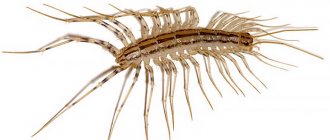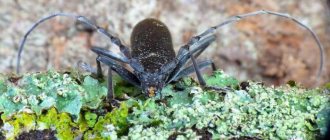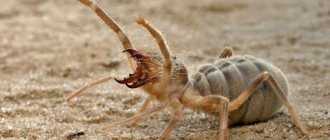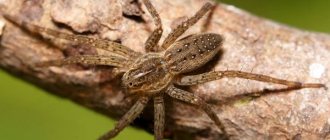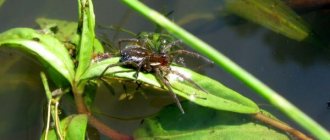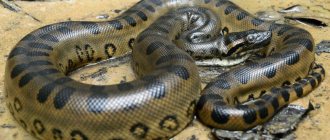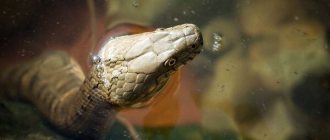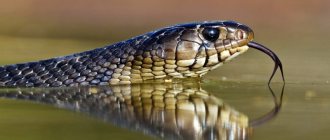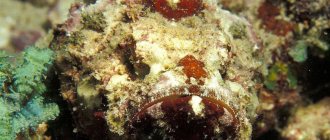To some people, flycatchers seem to be terrible creatures that can do a lot of harm. Others claim that these are the most useful creatures of nature and protect them. Let's figure out whether flycatchers are dangerous and what to do if you encounter them.
The common flycatcher is a predatory centipede of the genus Scutigera coleoptrata. It is also called the house centipede or the house centipede - it is important here not to confuse it with the real centipede, because there is a big difference between them.
The flycatcher hunts small insects and other arthropods, and does it very cleverly. Its diet consists of flies, midges, cockroaches, termites, two-tailed insects, moths, silverfish, spiders and other crawling and flying little things.
What does a flycatcher look like and where does it live?
The adult insect has an elongated, flattened body consisting of 15 segments. For each segment there is one pair of legs, the length of which increases from the head to the tail. The last pair of legs are so elongated that they look more like antennae (can be confused with the head). Due to the large number of long thin legs, scutigera looks like a hairy or shaggy centipede.
The first pair of legs are transformed into jaws, with which the centipede grabs prey and defends itself from enemies. When hunting, flycatchers inject poison into the body of the victim and then eat it. Flycatchers have good eyesight and a movement speed of up to 40 cm/sec. The antennae are whip-like, very long. The color is yellowish-gray or brownish, with three stripes along the body.
The flycatcher lives 3-7 years, growing up to 6 cm. You can distinguish an adult insect from a young one by the number of legs. The centipede that emerges from the egg has only 4 pairs of them. The number of legs increases after each molt, eventually reaching 15 pairs.
The range of flycatchers covers the distance from Southern Europe to North Africa. On the territory of Russia, it lives in the Black Earth Region, the Caucasus, Crimea and the Volga region.
Habitats
A description and photo of scolopendra can be found on the website. It is advisable to do this for those people who are going on trips to warm or tropical countries. It is there that the centipede and tropical scolopendra grow to gigantic sizes and pose a real danger to humans. Their body length reaches 26-30 cm. There are individuals up to 45-50 cm. Therefore, the question of where centipedes live is interesting for humans. They can be found on the islands of Jamaica, Trinidad, and in the north and west of South America.
Scolopendra
Basically, real scolopendras are found in the upper layers of the soil, under stones, lying logs, in rock crevices and other secluded corners, where humidity is maintained during the hot time of the day, and no one can disturb them. A natural question arises as to whether the poisonous centipede can be found in places with colder climates and, if so, where this predatory insect lives in Russia. There are different types of insects, some of which live in the Russian Federation.
What attracts flycatchers to a person’s home?
In nature, flycatchers live in fallen leaves; in the winter they crawl into places sheltered from the cold. They penetrate into human habitation mainly in the fall, due to the beginning of their passages. Room temperature is quite comfortable for these predators. In the house they choose dark places: spaces under the bathroom, basements, and continue to lead a predatory lifestyle - they catch all the insects they can find.
Classification
Centipedes do not form a fairly monolithic class, but are divided into groups so different from each other that many zoologists divide the class of millipedes into four different classes. We will consider these groups at the rank of subclasses. The class of centipedes (Myriapoda) is divided into four subclasses, two of which are of greatest importance: 1. Dipopods (Diplopoda); 2. Lipopods (Chilopoda).
Subclass Diplopoda
This largest group includes about 7,200 species of moisture-loving centipedes that live in the forest floor, under fallen trees and in stumps. They, unlike some labiopods, rarely climb tree trunks. Bipeds feed on rotting leaves and decaying wood. Due to their abundance, they bring significant benefits by participating in the mineralization of organic residues: forest litter, dead wood, etc. In our fauna, peculiar centipedes are common - nodule (genus Julus), with an almost round body in cross section, distinguished by a very large number of legs and slow movements. Nozzles, disturbed by something, curl up into a spiral.
Many bipeds have venom glands on the lateral sections of their dorsal scutes. In some tropical species of millipedes, the poison contains hydrocyanic acid; it was once used by Indians to poison arrows.
Subclass Labiopods Chilopoda
A large group (2800 species) of labiopods are represented by active predators, in contrast to all other millipedes, which feed on decaying or living parts of plants. The predation of labiopods is associated with the transformation of the first pair of their trunk legs into grasping jaws equipped with a poisonous gland.
Labiopods, like all centipedes, lead a predominantly secretive nocturnal lifestyle. During the day, you should look for them under fallen leaves and stones, in hollows and under the bark of dead trees, etc. A small (up to 3.2 cm in length) centipede drupe (Lithobius forficatus) is common in our fauna. She has 16 pairs of legs, of which the hind ones are greatly elongated and perform a tactile function. There are rather long antennae on the head.
In the Crimea, the Caucasus and Central Asia, small centipedes with very long limbs, called flycatchers, are found in human habitations (houses). Eyeless centipedes geophiles with a very large number of segments (more than 170) live in the soil, sometimes deep from the surface. Geophilus longicornis is common in our fauna.
The largest of the labiopods, the poisonous centipedes, are widely represented in the tropics. In the Crimea, the Caucasus and Moldova, the ringed scolopendra (Scolopendra cingulata) is found, reaching a length of 10-17 cm. Its bite causes not only severe swelling in humans, but also general poisoning. The temperature rises to 38-39°C, general weakness and headache are observed. However, all painful phenomena go away on their own after 1-2 days. The bite of the Brazilian giant scolopendra (S. gigas) also does not appear to be fatal.
Are flycatchers harmful?
The flycatcher is a useful creature that exterminates many insect pests. She is a real helper in the garden and vegetable garden. Therefore, if a flycatcher is found in the house during the warm season, it is better to carefully catch it with a jar or box (not with your hands!) and take it outside.
In the apartment, she does not damage the furniture and does not touch human food. She is only interested in insects, and in a few weeks she can clean an apartment of them no worse than a vacuum cleaner.
The flycatcher does not tolerate any diseases, does not attack humans or animals, and generally tries to stay away from all household members. Despite the fact that the insect is poisonous, its disposition is peaceful. If possible, she will not enter into conflict - she will simply run away. Of course, she can try to bite, but only in self-defense.
In southern countries, centipedes are welcome guests in gardens and fields; here they are protected and their contribution to the fight against agricultural pests is appreciated.
Nutrition
All representatives of the superclass are predators. They usually eat:
- ants and their larvae;
- domestic cockroaches;
- flies, ticks.
Some species, such as the giant and ringed scolopendra, found in South America and Jamaica, are capable of hunting mice, frogs and lizards.
Centipedes use poison to paralyze and kill their victims. However, there is no need to be afraid of them: the poison produced by centipedes is harmful only to small arthropods, but not to mammals. In rare cases, the poison can provoke allergies.
Centipedes feed as follows. Having caught the victim, they inject poison into them and hold it with strong jaws and paws until the insect is completely immobilized. Only after this do they start eating.
Centipedes also destroy insects that harm agriculture. In some countries, for this reason they are under government protection.
What happens if a flycatcher bites?
Most often, the flycatcher fails to bite through the skin, unless we are talking about delicate children's or very thin women's skin. If she does manage to pierce the skin and inject poison, the bite will feel similar to a bee sting, and the symptoms will also be redness, burning, itching. The flytrap venom is not dangerous for people; it can only cause harm if there is an individual intolerance or an allergic reaction.
The flycatcher may try to bite domestic animals, defending itself from them. As in the case of a person, she will hardly be able to bite through their skin. But even if this happens, its bite and poison will not entail negative changes in the condition of the pets.
Much more dangerous than flycatchers are centipedes, another type of centipede with which, out of ignorance, they are sometimes confused. Although the scolopendra bite is not fatal to humans (with the exception of tropical species of scolopendra), it is very painful and can cause severe swelling that does not subside for several days. Scolopendra venom is especially dangerous for small children and can kill a cat or other small animal.
Interaction with people
Centipedes generally have little impact on human economic or social well-being. At the local level, they can become an agricultural pest.
Centipede bites, burns
They don't bite. Their protective secretions are harmless to humans and usually cause only a slight change in skin color. The secretions of some tropical species can cause pain, itching, local erythema, swelling, blisters, eczema, and cracked skin.
The impact of discharge on the eyes causes general irritation, more serious consequences such as conjunctivitis, keratitis. Called centipede burn. First aid is to thoroughly rinse the area with water. Further treatment is aimed at alleviating local effects.
Pests
Some centipedes are considered household pests, including Xenobolus carnifex, which infects thatched roofs in India, and Ommatoiulus moreleti, which periodically invades apartments in Australia.
Other species exhibit periodic swarming behavior that results in home invasions, crop damage, and train delays when tracks become slippery with the crushed remains of hundreds of centipedes.
They can cause significant damage to crops: the spotted snake millipede (Blaniulus guttulatus) is a known pest of sugar beets and other root crops.
Some large centipedes of the orders Spirobolida, Spirostreptida, Sphaerotheriida are popular as pets.
Some cultures associate the centipede with rain. In Zambia, the crushed insect is used to treat wounds. The Bafians of Cameroon use centipede juice to treat earache.
The indigenous people of Malaysia use their secretions in poisoned arrows. The secretion of Spirobolus bungii was found to stop the division of human cancer cells. People from Burkina Faso eat boiled, dried centipedes in tomato sauce.
What to do if bitten by a centipede (flycatcher, centipede)
When bitten you need:
- Wash the wound with soap and water.
- Disinfect with any suitable means: for example, alcohol, vodka, cologne, boric acid or calendula tincture.
- Apply a cold compress for 40 minutes if the burning sensation is severe and swelling has formed.
- Take a pain reliever or antihistamine if necessary.
Next, you need to observe changes in your well-being. If alarming symptoms appear (severe malaise, nausea, confusion, vomiting), you should consult a doctor. As a rule, nothing like this happens.
In the case of scolopendra, everything is much more serious - the result can be severe swelling (if a limb is bitten, it will swell entirely), an increase in temperature and a sharp deterioration in well-being.
If you are bitten by a scolopendra, instead of a cold compress, you can apply a heating pad with a temperature of 45 °C. Under the influence of this temperature, the scolopendra venom is partially destroyed, and the person feels better. But still, in this case, it is better to immediately seek medical help, and if a child or small pet is bitten, it is imperative to seek help from a doctor.
Prevention
Prevention of centipedes:
- carry out regular cleaning;
- ensure that no puddles form near the pipes;
- make cosmetic repairs if necessary;
- do not litter the adjacent area;
- seal all holes and cracks in the walls to prevent unwanted neighbors.
Stories from our readers!
“We have always used fertilizers and fertilizers in our garden. The neighbor said he was soaking the seeds using new fertilizer. The seedlings grow strong and strong.
We ordered and followed the instructions. Wonderful results! We didn't expect this! We harvested a wonderful harvest this year, and now we will always use only this product. I recommend trying it."
Why are people afraid of flycatchers?
The fear of centipedes and the hostility towards them on the part of people is explained mainly by two facts: disgust for their appearance and fear that they might get into the ear. The last statement is more related to the common myth about earwigs, which, according to some people, are able to get into the ear of a sleeping person, bite through the eardrum and penetrate the brain. Flycatchers are confused with earwigs, so they are just as feared.
In fact, neither the flycatcher nor the earwig has any intention of getting into human ears, much less capable of gnawing on the eardrum and brain. Besides, they don’t need it at all; they don’t feed on the brain.
It happens that small insects get into people's ears (most often these are flies, midges or cockroaches). Under no circumstances will a flycatcher climb into the ear canal - there is nothing attractive there for it and with its long legs it is completely inconvenient.
Incubation period
The incubation period is the time that elapses from the moment a person comes into contact with the pathogen until signs of infection appear. For the Delta strain, scientists reliably calculated the duration of the incubation period; it was 4.4 days. For the new strain, the exact duration of the incubation period is not yet known. The incubation period for omicron is expected to be 3-6 days, but it can vary significantly from country to country. The rapid increase in the number of infected people indicates a decrease in the duration of the incubation period.
Flycatchers in the house - how to get rid of them
There are not many flycatchers in a living room, because this is an unusual habitat for them, and they are unlikely to breed in an apartment. Therefore, flycatchers can be easily caught and sent outside.
If you decide to get rid of flycatchers in your apartment using radical methods, that is, destruction, you need to take into account the peculiarities of their nutrition, body structure and behavior. For example, if sticky traps are removed, they are ineffective in combating insects - the insect tears off the stuck legs and runs away. Baits for cockroaches and ants also have no effect on them, because flycatchers are predators; they feed on live insects.
You can kill a flytrap with any hard object, boiling water or insecticide (it’s more convenient to use sprays). Any insecticide will do; flycatchers are not resistant to them.
You can make the flycatchers leave the apartment on their own. For example, if you get rid of all the insects in the apartment, they will have nothing to eat and will have to go in search of a more suitable place.
They love humidity, so you can often encounter them in the bathroom. If you do not allow moisture to accumulate in the bathroom and ventilate it regularly, the flycatchers will soon become uncomfortable here and will leave.
You can block access to the house for flycatchers, as well as various insects, by caulking all the cracks in the walls, floor and basement, as well as installing mesh on the ventilation outlets.
Prevention
Coping with the invasion is half the battle. Without proper prevention, arthropods will return to your home. To prevent this from happening, follow our recommendations:
- keep the rooms clean;
- seal all the cracks, do cosmetic repairs;
- get rid of the food supply (centipedes feed on small insects);
- fix faulty plumbing fixtures.
Dry and clean rooms do not attract insects. Are there gnats, spiders or flies? Next in line are centipedes. Keep the apartment dry and clean, ventilate the rooms, and seal the cracks. All these are guarantees of safety.
Literature
1. N.V. Orlova, T.G. Suranova. Acute respiratory diseases: clinical features, drug therapy. MEDICAL COUNCIL • No. 15, 2022. pp. 82-88. 2. V.M. Delyagin. Fever (new touches on an ancient painting). Consilium Medicum. Pediatrics. (App.) 2018; 2: pp. 89-93 3. Dvoretsky L.I. Feverish patient. Place and benefits of antipyretics. "RMZh" No. 19 dated 09/07/2011. P. 1166 4. Martynov, A., Malyavin, A., Zhuravleva, M., Bolieva, L., Esaulenko, E., Babak, S., Kalyuzhin, O. Consensus of the expert council of the RNMOT “Improving the results of treatment of respiratory tract infections "Preventive Medicine, 2022, 22(4); 144-151 5. Instructions for the medical use of the drug TheraFlu® for influenza and colds. RU P N012063/01 dated 05/31/2011 6. Tatochenko V.K. Use of antipyretics in children. Issues of modern pediatrics. 2004, volume 3, no. 5, pp. 70-73. 7. Melnikova I.M., Mizernitsky Yu.L. Rational use of antipyretics for acute respiratory diseases in children // Medical Council - No. 2, 2022 - P. 77-81. The trademark belongs to or is used by the GlaxoSmithKline Group of Companies JSC GlaxoSmithKline Healthcare, Russia, 123112, Moscow, Presnenskaya nab., 10, premises III, room 9, floor 6,.
